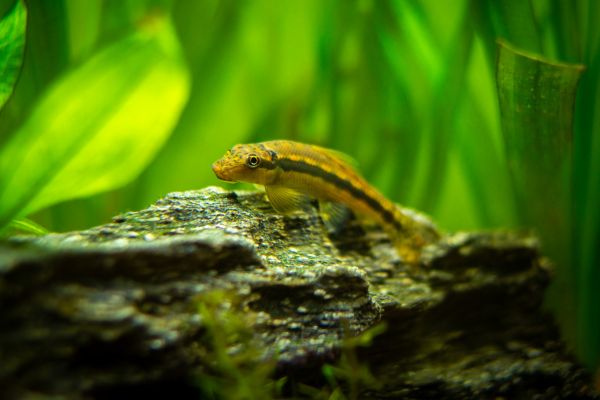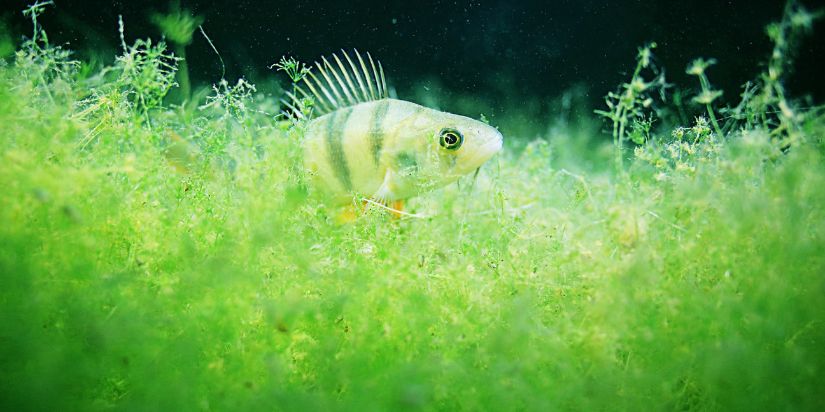It’s a moment many aquarium hobbyists will never forget – you’ve just set up your tank. It’s been populated with all the living things you want, and you put in place the equipment needed for proper fish tank maintenance… only to find that your aquarium is under invasion one morning.
Maybe a mysterious goo is growing through your substrate. Or perhaps a slimy film is forming on the glass. You might have noticed some rocks seem to have hair growing on them, or your water is growing misty with a green haze. It could be a combination of any of these.
What’s going on? Did you do something wrong? Is your aquatic life in danger from this invader? It’s normal to have many questions when you experience this seemingly odd phenomenon, especially for the first time. But there isn’t a reason to panic just yet. Instead, keep reading below to learn what’s happening, how to identify if this is an actual problem and much more.
Algae Doesn’t Always Indicate a Fish Tank Maintenance Problem
These organisms you’re suddenly finding in your tank may look like an aquatic disease or infection – some may even look like some sort of creeping alien horror from a sci-fi film. However, aquarium hobbyists simply call them “algae,” which is likely a term you’re familiar with.
Algae are a diverse group of aquatic organisms that can occur anywhere there’s light and water with nutrients. Algae survive using photosynthesis like the plants on dry land do. Believe it or not, many algae are beneficial to seascapes, aquatic life and even human health.
While these organisms might sound or look like an infection by some aquatic disease or some sort of creeping alien horror from a sci-fi film, aquarium hobbyists know them as algae, a natural occurrence wherever there’s water with nutrients and light. Some algae may be welcome in your tank under certain conditions, perhaps as a food source for your livestock or as a component of a more natural aesthetic.
Unfortunately, this isn’t always the case. Some algae can harm your newly designed aquatic seascape and the life you’ve filled it with. Rarely, algae can be life-threatening to humans, too. That’s why learning proper algae identification and how to control their presence when necessary is an essential part of good fish tank maintenance.
Common Types of Algae You Should Know About
To help you get started, the experts here at Living Art Aquatics have compiled the following list of common algae types and how they affect your aquarium. We also share what fish tank maintenance may be required to get rid of any harmful algae that have appeared.

Blue-Green Algae
Though not technically an algae, cyanobacteria, also known as slime algae or smear algae, sure look like one and can cause problems like an algae does. Starting simply as a slimy film in your substrate, blue-green algae will creep up through it and into your fish tank. Upon reaching the top layer, blue-green algae will rapidly spread throughout the tank, killing plants along the way.
Removing cyanobacteria mechanically will help cull the overgrowth but won’t keep it from quickly growing back. Since cyanobacteria can fix its own nitrogen, it’s hard to prevent it even with good fish tank maintenance. And because of its toxicity, many algae eaters won’t touch it.
Once you remove the blue-green algae mechanically, you should turn the lights off for three days, performing partial water changes of about 15% before and after. If it grows back, repeat the process. This should help you control overgrowth but won’t truly eliminate it.
In extreme cases, you can kill blue-green algae with erythromycin phosphate. Still, this compound can also harm the helpful nitrifying bacteria you want in your aquarium and help the cyanobacteria develop antibacterial resistance if not used correctly, so use with caution.
Green Water
This algae reproduces so rapidly that it fills your water, giving it a hazy green tint. It occurs when faulty fish tank maintenance allows excess nitrates, phosphates or lighting —especially direct sunlight. This is called an algae bloom, and while not harmful to your aquarium’s inhabitants, it can certainly ruin its aesthetic appeal.
Green water can actually be helpful if you’re raising brine shrimp or daphnia, which eat these algae. If you aren’t, you can use them to eliminate it—introduce a large number, and they’ll eat the algae before getting eaten by fish.
More direct methods include UV sterilizers, which prevent algae blooms in the first place, and diatom filters or micron filter cartridges, which will quickly remove the algae from your water.
Brown Algae
These brown patches of algae grow when your aquarium has too much silicate and phosphate but not enough light. They can easily be scraped off and eliminated by increasing the light.
They may also appear because you use a cool white “shop light” bulb or an old fluorescent lamp. These tend to emit a spectrum of light that favors brown algae growth. Always use a bulb made for aquariums and replace it twice a year as part of your fish tank maintenance.
Spot Algae
Green spot algae appear on the leaves of slow-growing plants and glass surfaces. It typically indicates good water quality and can be easily removed by simply scrubbing or scraping it off. A razor blade or scraper will get the job done.
Black spot algae are more of a nuisance, as they’ll spread up the base of plants and throughout the tank. Plus, it’s much harder to remove mechanically. Removing black spot algae is more effectively accomplished by introducing algae-eating organisms, particularly Nerite snails and Amano shrimp.
Hair Algae
Hair algae live up to their name, appearing in long, wispy strands. These come in green, brown and black varieties, which appear under slightly varying conditions (typically excess nutrients and light). But all hair algae can grow fast enough to overtake your aquarium, making them bad algae.
Regardless of what color the hair algae in your aquarium are, the removal process is generally the same. Remove as much as you can by hand with a toothbrush and introduce Amano shrimp and Siamese algae eaters to take care of the rest.
Staghorn Algae
These algae might resemble strands of black hair algae, but up close, you can see that this greyish algae branches off the surfaces of leaves and equipment in the shape of a deer horn. This is a harmful alga and is very hard to remove.
Cutting off affected leaves is a good start, but you’ll need algae eaters. Amano shrimp are the most effective.
Fish Tank Maintenance for Algae Control
While these solutions can help you combat algae that have entered your aquarium, good fish tank maintenance is the most effective method of keeping harmful algae at bay.
Keeping a group of hungry algae-eating organisms, such as Amano shrimp, Siamese algae eaters, Nerite snails or even a common pleco, is the most effective step you can take in maintaining an aquarium free of undesirable algae.

However, you must also tackle the root causes, which lie in your fish tank maintenance.
As you may have noticed, many of these algae appear because of excess light or nutrients. To prevent this, you should clean your tank and change your water regularly, as water that is not routinely changed tends to become high in phosphates and nitrates. Aquarium water changes are crucial to maintaining a healthy environment for your aquatic life.
An even more significant source of excess nutrients is overfeeding. Most fish only need to be fed once a day, and if food settles at the bottom ten minutes after feeding, you may be overfeeding.
Of course, even with all these fish tank maintenance measures, you will still always have some bit of algae growth. This is simply a normal part of having water, light and nutrients in one place, and it isn’t always necessarily bad.
Choose Professional Fish Tank Maintenance Services
Of course, the easiest course of action is to get professional help with your aquarium care. At Living Art Aquatics, we can provide ongoing fish tank maintenance to support your aquatic life and maintain your tank’s aesthetics.
We’re also here to help in any way we can! So, if you have questions about these and other kinds of algae growth in your aquarium, Living Art Aquatics in Cary, IL, has the expertise you’re looking for.
Editor’s Note: This blog was originally published in July 2016 and updated in December 2023.







